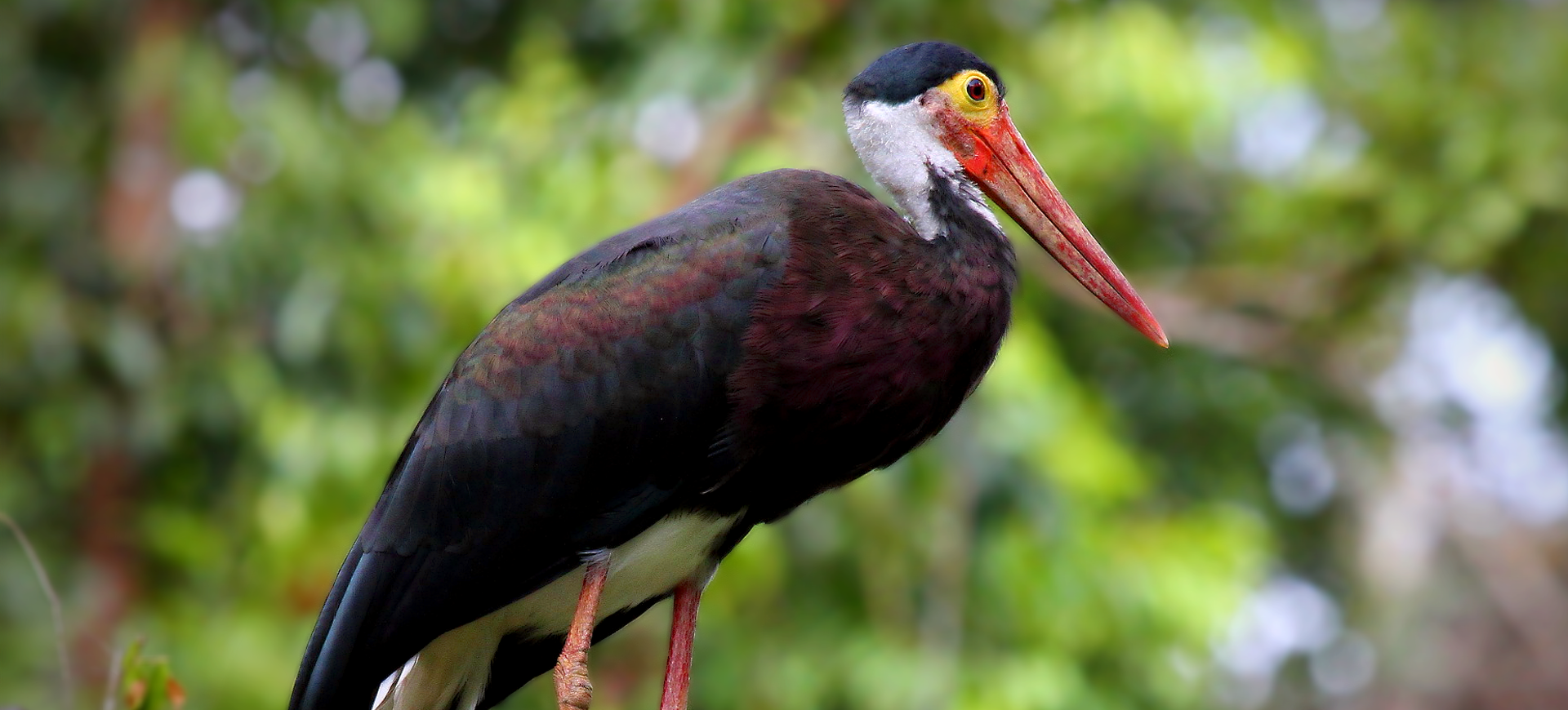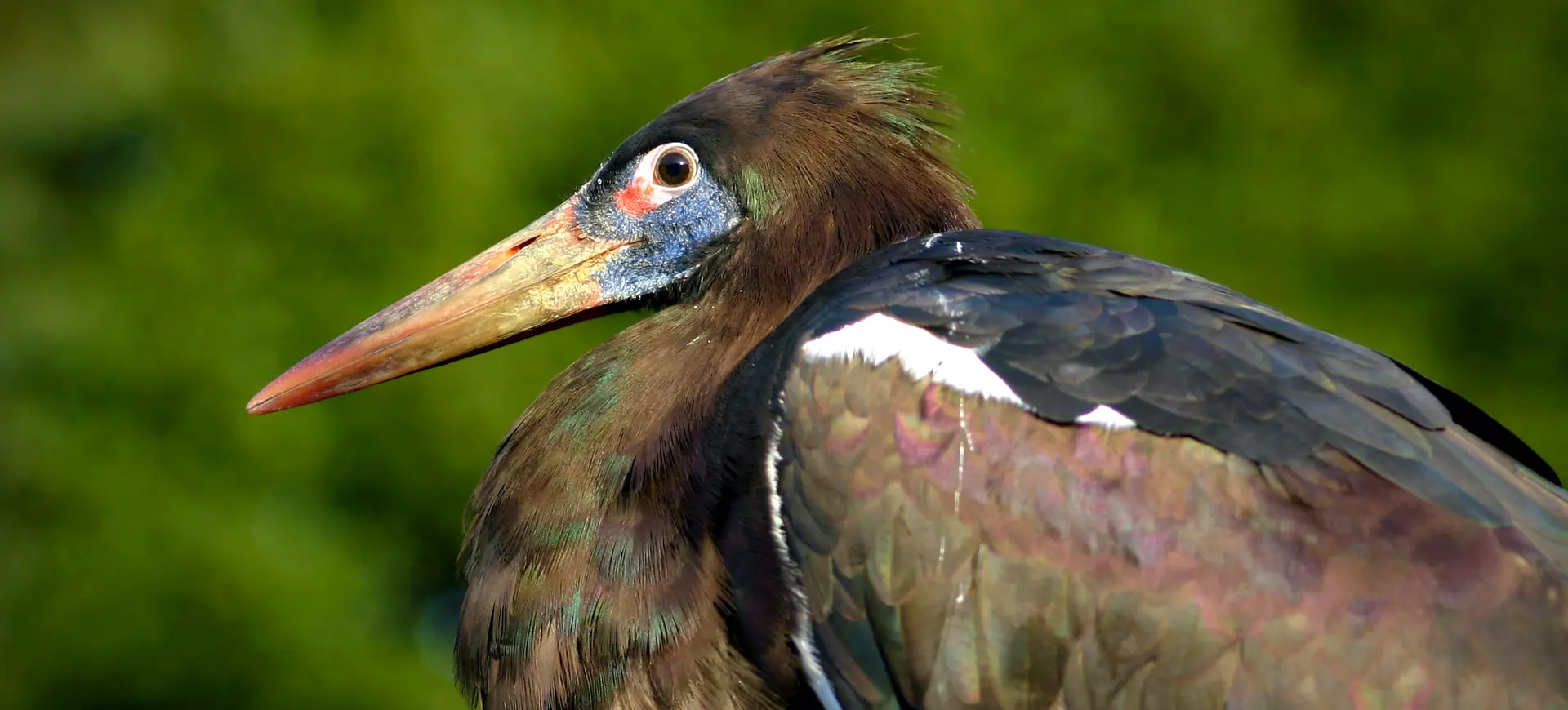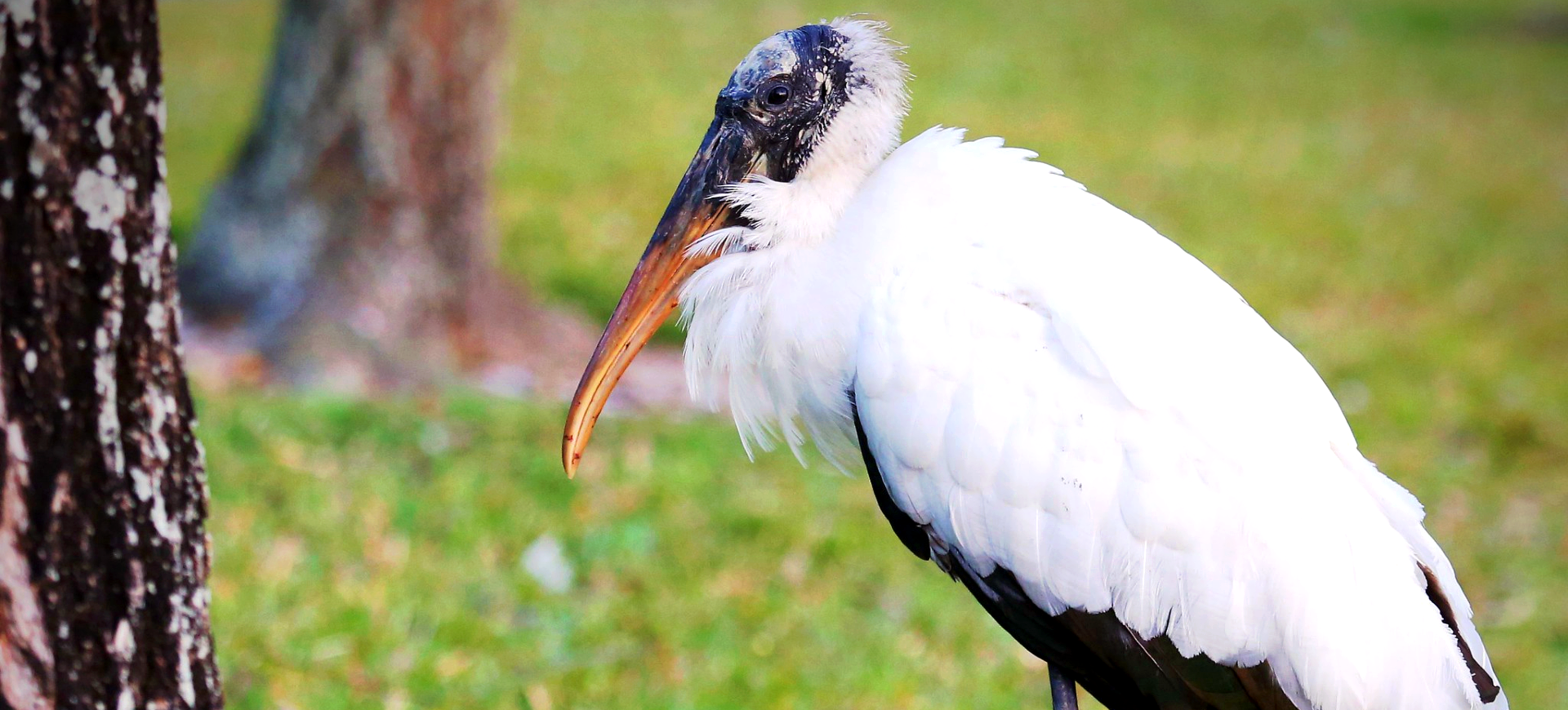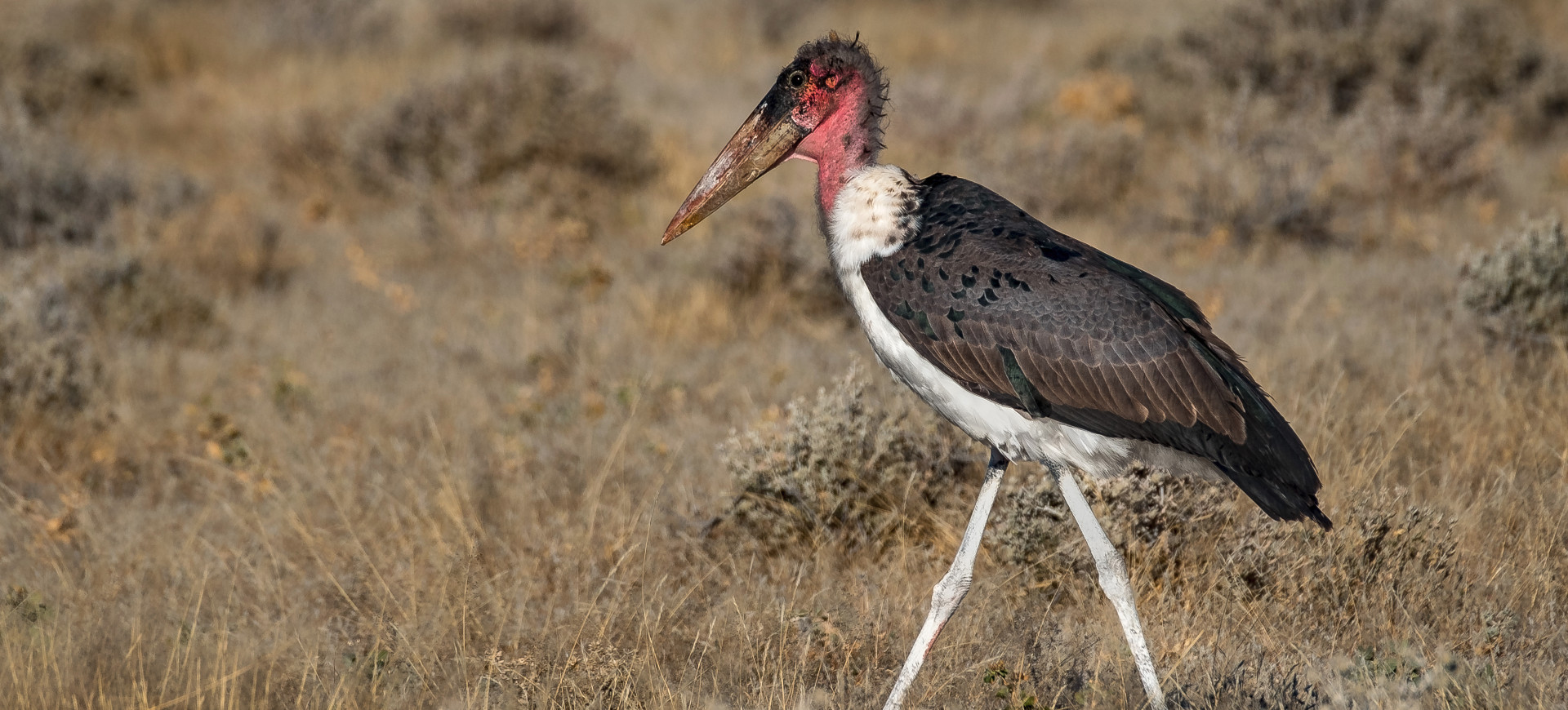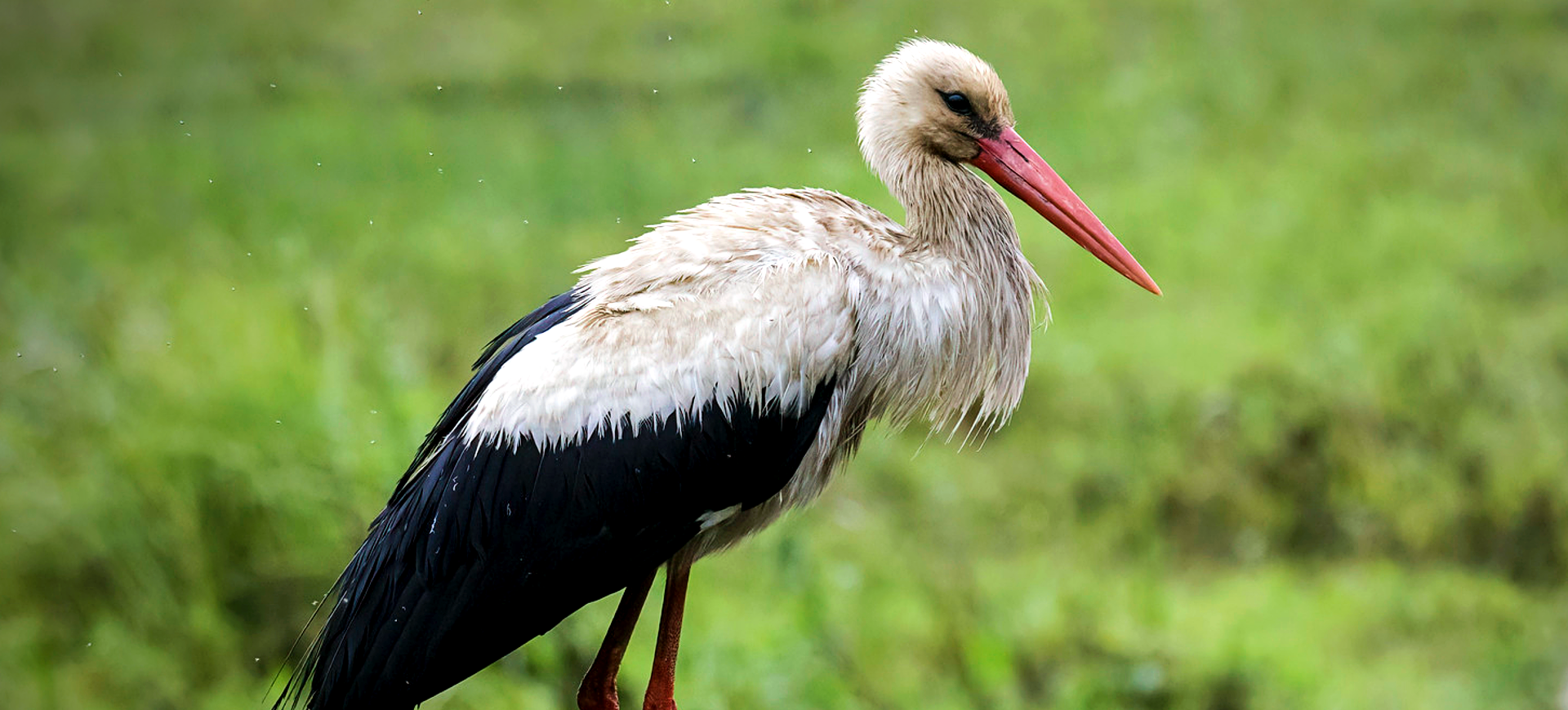Overview
The Saddle-billed Stork (Ephippiorhynchus senegalensis) is a large wading bird in the stork family, Ciconiidae. It stands tall, reaching up to 150 cm (5 ft), making it one of the tallest storks. This stork is strikingly majestic with its bright red and black bill, detailed with a black band and yellow frontal shield (the ‘saddle’), which is the inspiration for its name. Males have dark eyes and drooping yellow wattle, while females have yellow eyes.
Distinguished by its long, slender legs, it stands erect and moves elegantly. Its body is predominantly black with a stark white underside, chest, and parts of the wings. The wings are expansive, capable of a great span that enables the bird to fly gracefully, balancing its towering height. The tail has a unique double banding of black and white.
The Saddle-billed Stork is a non-vocal species, with communication being primarily non-verbal, and manifests as bill-clattering, used primarily in courtship and bonding rituals. This characteristic, combined with its prominent coloration and stature, makes it a fascinating creature to observe in the wild and captivity.
Taxonomy
Kingdom
Phylum
Class
Order
Family
Genus
Species
Type
Physical Description:
The Saddle-billed Stork is a robust bird with a tall, upright stature. Its long, thin legs support a substantial body with an elongated neck leading to its defining feature, the long, saddle-like bill. The bill is strong and sharp, designed for catching and holding onto its prey, often including fish, frogs, and small birds or mammals. Male Saddle-billed Storks can be distinguished from females through eye color and the presence of a wattle – males have dark eyes and a wattle, while females possess yellow eyes and no wattle.
Their plumage is largely white, with black flight feathers and tail. These color differences make a striking contrast when the bird is in flight, with the black and white distinctly visible. Their long legs, often submerged while they wade through their wetland habitats, are pinkish-red in color, complementing the red portions of their bill.

Lifespan: Wild: ~30 Years || Captivity: ~35 Years

Weight: Male & Female: 12.1–19.8 lbs (5.5–9 kg)

Length: Male & Female: 35–59 in (89–150 cm)

Height: Male & Female: 4.5–5 ft (1.37–1.52 m)

Wingspan: Male & Female: 7.7–9.2 ft (2.4–2.8 m)

Top Speed: 30 mph (48 km/h)
Characteristic:
Native Habitat:
Saddle-billed Storks inhabit tropical Africa, preferring wetlands, which include marshes, riverbanks, and the edges of lakes. They can also be found in dry and flooded savannahs, particularly during the wet season when water bodies expand. These habitats provide ample foraging opportunities for these storks, which rely on wet environments for their hunting techniques. They are often seen alone or in pairs but rarely in large groups.
The breeding season can affect their location, as they will nest in tall trees near water bodies. These nests are substantial structures and are typically used for consecutive years. These birds do not migrate and tend to stay within a defined home range, where they reside permanently, unless disturbed by extreme environmental changes or loss of habitat.
Climate Zones:
Biomes:
Biogeographical Realms:
Continents:
Countries:
Diet:
Diet & Feeding Habits:
Saddle-billed storks are predominantly carnivorous creatures renowned for their diverse diet. They primarily feed on aquatic organisms such as fish and frogs, which they efficiently catch using their sizeable, uniquely-shaped bills. Crustaceans, another significant part of their diet, are consumed frequently due to their abundance in the stork’s marshy habitats. In addition, saddle-billed storks also prey on small birds and reptiles, showcasing their adaptability and versatility in feeding.
The storks’ feeding strategy is primarily opportunistic, meaning they consume whatever they can find within their reach in the water or grasslands. Their hunting approach is fascinating; these birds typically hunt leisurely, strolling in shallow water, using their long, sensitive bills to probe muddy bottoms or vegetation for unsuspecting prey. This method proves incredibly effective, allowing them to exploit various environments and food sources depending on their immediate availability. This adaptability aids in their survival across different habitats, making them one of nature’s skilled opportunistic feeders.
Mating Behavior:
Mating Description:
Saddle-billed Storks are monogamous and form pair bonds that last for life. The courtship ritual involves mutual preening, dancing, and a distinctive bill-clattering sound. Nest building serves as a part of their courtship ritual, and both sexes participate in constructing a large stick nest in a tree near water.
Nesting takes place in the dry season to coincide with the peak of the rainy season, which offers the highest food availability for their offspring. The female typically lays two to three eggs which both parents incubate. After hatching, both parents share responsibilities for feeding and protecting the young. The chicks fledge at around 70 to 100 days but remain dependent on their parents for several months.
Reproduction Season:
Birth Type:
Pregnancy Duration:
Female Name:
Male Name:
Baby Name:
Social Structure Description:
Saddle-billed Storks are mostly solitary birds typically seen alone or in mated pairs. They have strong territorial instincts and defend their territories aggressively from other pairs. The bond between a mated pair is strong and lasts for life, with both parents participating equally in raising their young.
Outside the breeding season, interactions between individuals are limited, and no communal roosting or social gathering is known in this species. Despite their solitary nature, they are not shy birds and can often be seen foraging near large mammals or other bird species in the open.
Groups:
Conservation Status:
Population Trend:
The exact wild population size of the Saddle-billed Stork is unknown, but it’s estimated to range between 5,000 and 17,000 individuals, which is believed to be decreasing. The bird is distributed across a large range, and sightings are sporadic due to the species’ solitary nature and preference for undisturbed habitats. Though not considered threatened, these birds may be locally rare in parts of their range due to habitat degradation and human disturbance.
They have a high reproductive potential but a low population density, and their reproductive success can vary yearly based on food availability and environmental conditions. The age at first breeding is three to four years; a pair can raise one to two chicks yearly. However, the survival rate of chicks is unknown, and adult mortality rates are low.
Population Threats:
While not currently at high risk, Saddle-billed Storks face various threats, largely from human activities. Habitat loss and degradation are major threats to this species, primarily from the drainage of wetlands for agriculture and other development activities. Pollution of water bodies can also affect their food supply by reducing the quantity of fish and other prey or introducing harmful substances into the food chain.
Additionally, human disturbance, particularly during the breeding season, can disrupt their nesting and lead to the loss of eggs or chicks. Climate change may also pose a future threat by altering the availability and distribution of wetland habitats, potentially leading to shifts in their range or population declines.
Conservation Efforts:
Conservation efforts for the Saddle-billed Stork have primarily focused on protecting its habitat. The designation of protected areas, including wetlands and national parks, has provided these birds with safe havens, ensuring they have access to the necessary resources for survival and reproduction. In these protected areas, the disturbance is minimized, and efforts are made to maintain the health of aquatic ecosystems.
There are also broader efforts to conserve wetland habitats and implement sustainable land use practices to prevent habitat loss and degradation. Environmental education initiatives are important to raise awareness about this species and promote its conservation. While it is not the focus of any species-specific conservation programs, the Saddle-billed Stork benefits from measures aimed at conserving biodiversity and ecological integrity in its range.
Additional Resources:
Fun Facts
- Saddle-billed storks are silent as they lack the vocal organ known as a syrinx most birds use to produce sound.
- They are one of the largest species of storks in the world.
- The females and males look similar, but you can tell them apart by the color of their eyes – the males have brown eyes, and the females have yellow eyes.
- Saddle-billed storks are monogamous and believed to mate for life.
- They can live up to 30 years in the wild and even longer in captivity.
- The large bill of the saddle-billed stork is hollow, which helps to keep it lightweight.
- They prefer to hunt during the early morning and late afternoon.
- Females usually lay two eggs, and both parents help to incubate them.
- Despite their size, these storks are excellent flyers.
- The ‘saddle’ in their name refers to the yellow shield on their bill, which looks like a saddle.








